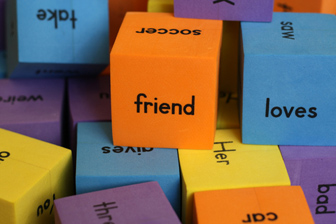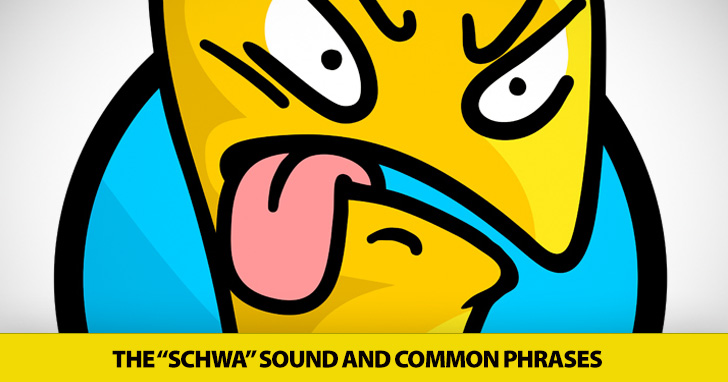yes Yes YES! How to Teach Sentence Stress


The schwa sounds approximately like “uh” in the phrases “uh-huh” and “huh-uh.” It is transcribed in the phonetic alphabet as an upside down “e.” (ə)
The schwa is important to English because of the stress pattern of English, called by poets “iambic,” a series of stressed then unstressed syllables. Most unstressed syllables’ vowels are pronounced as the schwa sound. In just analyzing the word “pronounced,” for example, we can see that it is actually said in American English as “pruh-NOWN-cuhd,” the unstressed first and last syllables reduced or shortened to the schwa sound. This reduction of unstressed vowels to schwa has important implications for spelling; it can be relatively difficult to learn spelling in the U.S. because this lack of correspondence between the written and spoken forms. Indeed, we hold national spelling contests to recognize those who master this skill. Even professionals of language use, such as writers, make frequent use of their dictionaries. Again, using “pronounced” as an example, if I did not know the spelling of that word and were trying to spell it by sound, I would not be able to tell if the correct spelling was “pranouncud” or “prenouncid” or “prunounced,” etc. as all of those spellings would be said approximately the same way, with two uses of the schwa in the first and last syllables.
In addition to its effects on spelling, the unstressed schwa vowel has implications for pronunciation, also. Without knowing this pronunciation pattern of stressed and unstressed schwa vowels, the student will have a very difficult time understanding and being understood in American English. Therefore, teaching students to recognize and use the schwa sound is an important part of any English speaking skills class.

Students are likely never to have heard of the schwa before. Once you define it and exemplify it, they will realize they’ve been hearing it as long as they’ve spoken English. Write the symbol of schwa on the board and define it.
Draw words at random from a text. Almost any multi-syllabic word in English will have the schwa sound. Use students’ names as examples, especially those that have been “Americanized” or “anglicized.” Compare the American version to the home culture’s. I’ve used my own name: the American “STAY-shuh,” with the second syllable reduced, in contrast to the more European “Stah-cee-ah” with all of the syllables approximately of equal stress and not reduced.
Students are likely to already know that “uh-huh” means “yes” in American English and “huh-uh” means “no.” If they don’t know this, they should learn, as this is an important feature of conversational English. It is also a very good, as well as humorous, example of the schwa sound.
Another important method to teach the schwa sound, after students have learned its definition, is to identify the sound in rapid speech. This is important because the schwa sound is typically used in conversation, in a rapid flow of speech, rather than in pronouncing a single word in isolation. In focusing on a single word, we are more likely to not reduce any of the syllables or use the “schwa” sound as we would in the flow of conversation. Have students listen to taped dialogues to pick out the schwa. It may take several times listening to a conversation to catch the reductions and assign meaning to them.
Finally, once students have learned what the schwa is and can identify it, it is time to use it. Students can start by learning some common phrases with schwa: “How are you doing?” “How do you do?” “Nice day today, isn’t it?” “Do you want to go to lunch?” and so forth all have the schwa sound in them. Teach students these common phrases with the schwa and have the students organize the phrases into dialogues they can practice.
Almost all ESL speaking and listening texts have dialogues. Students can practice these dialogues with a classmate, focusing in particular are their use of the schwa sound.
Reading aloud also can help in analyzing where the schwa typically occurs: in unstressed syllables in both written and spoken language. This is also a way for students to get a firmer grasp on the pronunciation of individual words with the schwa which they may not be able to analyze in the rapid flow of conversation.
The schwa sound, contrary to what some believe, is not just used in conversational but also formal English. While the schwa might typically be used in such conversational phrases as “Do you want to get a cup of coffee?” because there are more reduced syllables in conversational English, the schwa is also clearly present in academic language. The schwa is used in such “academic” sentences as “The government’s infringement on the freedoms of speech and religious practice is clearly unacceptable.” The words “government,” “infringement,” “freedom,” and “religious” all have ending syllables reduced to schwa. Beginning syllables as well are reduced in “religious” and “unacceptable.” In fact, almost all of the multi-syllabic words in that sentence have reductions and the schwa sound. Finally, short “structure” or “grammatical” words which carry little meaning on the own, such as “and,” “the,” and “of” are also reduced to schwa. At the most, academic as well as conversational language indeed would be difficult to understand without the correct use of the schwa and reduced syllables. At the least, it is really the mark of a nonnative speaker, not native speaker, to speak in complete sentences with all syllables stressed, and if the student aspires to native-like English pronunciation, how to reduce syllables to schwa should be learned.
Pronunciation in general, the use of reductions and of the schwa specifically, can be difficult to teach for a number of reasons. The reduced syllable schwa is a difficult concept to grasp to begin with, and is seemingly a minor issue, one sound, but it has huge implications because almost all unstressed syllables in English go to schwa. Where to stress and reduce syllables also is not obvious and must be practiced for students to learn typical patterns of reduced and stressed syllables. In addition to teaching the use of the schwa, the instructor might be battling a number of wrong, preconceived notions: that it is a mark of educated and academic language, for example, to pronounce each syllable clearly as it is written while in actuality it is more the mark of a nonnative speaker of English to pronounce each syllable distinctly. Not reducing unstressed syllables can actual impede, not aid, comprehensibility. However, through explicit instruction, teaching typical patterns of occurrence, and listening and speaking practice, students can gain strong control of the use of the schwa.